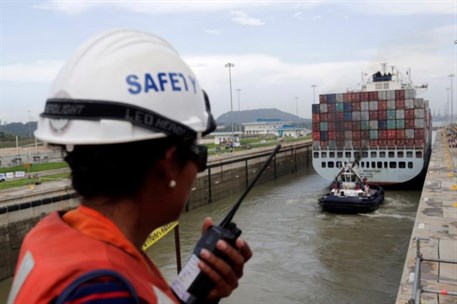Panama Canal readies for surge in tonnage after upgrade

A worker talks on a walkie talkie as cargo ship named Cosco Houston, navigates through Cocoli locks during a test of the new set of locks of the Panama Canal expansion project on the Pacific side in Cocoli, on the outskirts of Panama City. Photo courtesy of Reuters.
(Reuters) The Panama Canal is likely to attract up to 15% more tonnage next year after an upgrade which means it can now accommodate gas tankers previously too large to transit, its operator said on Thursday.
The expanded canal opened in June, fitted with new locks that allow ships three times bigger than previously to pass through.
"We expect to get ... more tonnage specifically because of the expansion," Panama Canal Authority Chief Executive Jorge Quijano told Reuters in an interview at the Danish Maritime Forum conference in Copenhagen.
"Hitting those targets will of course depend on the (global) economy ... But in the worst of cases I think we will see 10% and in the best of cases 13%-15%."
Container shipping tonnages were up, "but we also have LNG shipments that we didn't have before." Both LNG and LPG carriers were contributing to the increase, he said.
Shipping industry experts told Reuters in August that many large tankers were undergoing inconvenient retrofits to pass through the canal's new locks. The Authority acknowledged at the time that some vessels would probably need new chocks and bollards added.
"We've only had three bulk carriers that are larger than Panamax going through the expanded canal," Quijano said.
Quijano said it was far from certain that Egypt would succeed in efforts to persuade container shipping firms to agree to advance toll payments in exchange for discounts.
"I've had discussions with (Suez Canal Authority Chairman Mohab) Mamish and he seems very gung ho on that this will actually take place. But it depends really on the customer."
He said the Panama Authority would not rule out something similar.
But it already operated a 'frequent flyer' system for container vessels and would take time to assess how the expanded version was operating in terms of tonnage and efficiency before making any changes to its toll structure.
"Maybe by 2018 we'll have a full year of 2017 and part of 2018 to implement a structure that is a little bit more flexible," he said.
Its expansion would give the Panama Canal an extra layer of protection against economic downturns and the shipping industry's current struggles.
"We are always hoping economies will pick up," he said.
"But our growth is ... now more related to the fact that we can offer economies of scale and gain back what we have lost from other areas."
Reporting by John Stonestreet; Editing by Ruth Pitchford

- ExxonMobil halts 1-Bft3d blue hydrogen project in Texas
- Aramco and Yokogawa commission multiple autonomous control AI agents at Fadhili gas plant
- Ukraine will resume gas imports via Transbalkan route in November
- Mitsubishi to inject $260 MM into Brunei LNG project
- Freeport LNG (U.S.) on track to take in more natgas on Thursday after unit outage



Comments